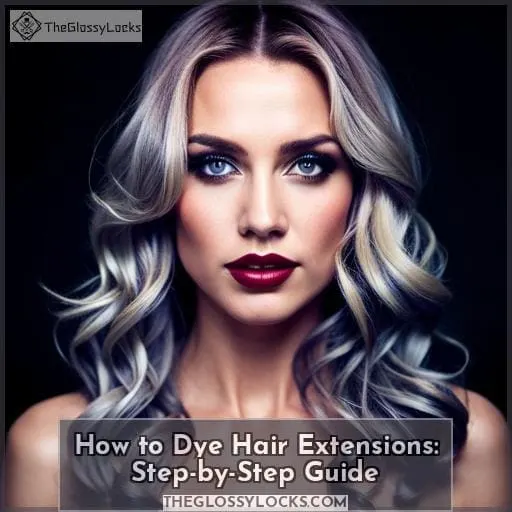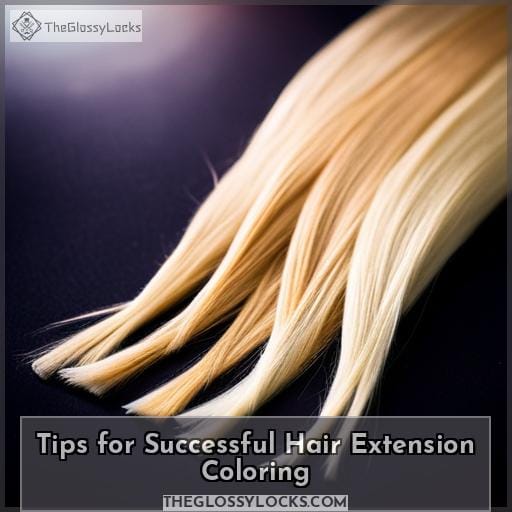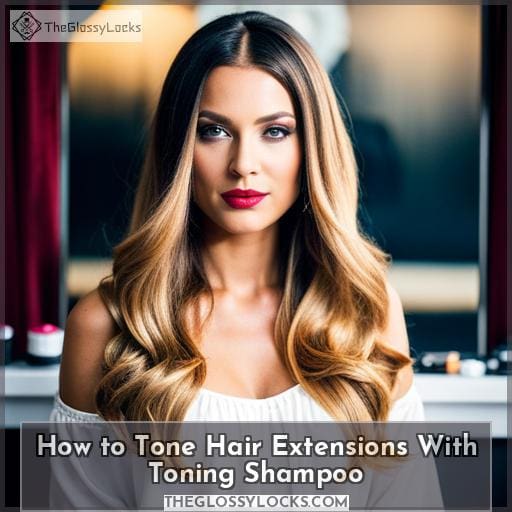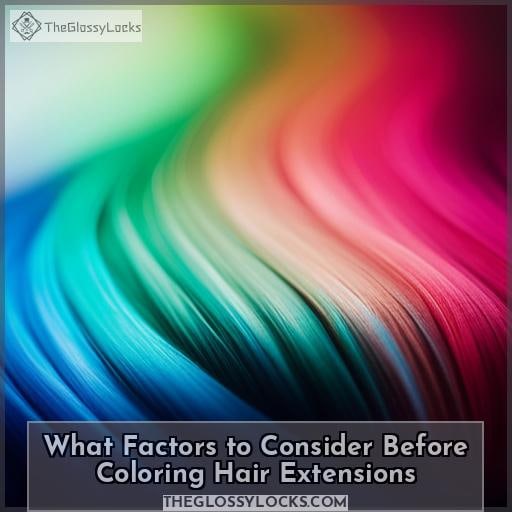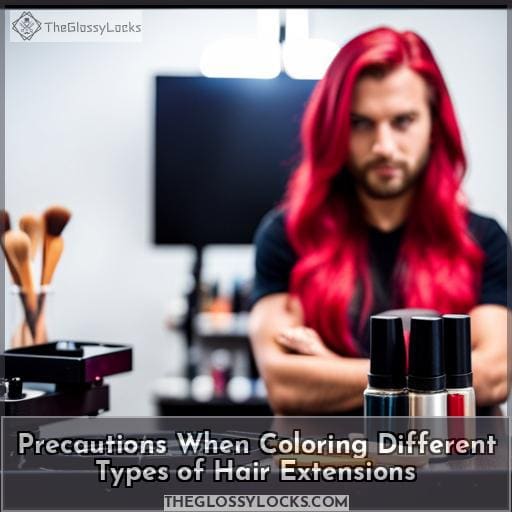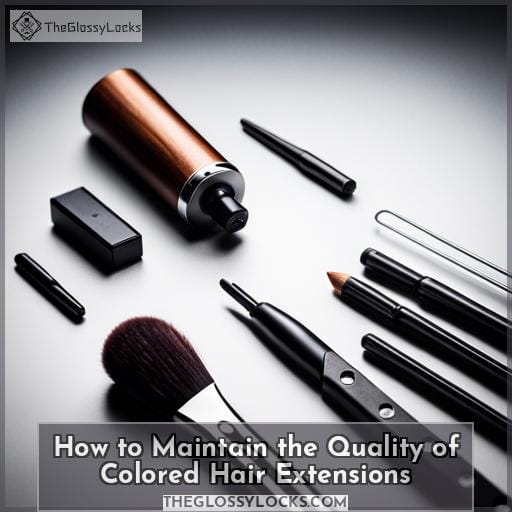This site is supported by our readers. We may earn a commission, at no cost to you, if you purchase through links.
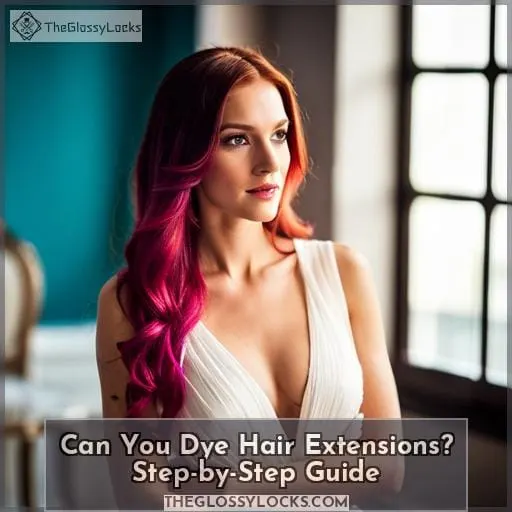 As a master artisan changes the color of an exquisite tapestry, so too can you dye your hair extensions to create a unique look that is all your own. With the right technique and tools, you can change up not only the shade but also the style of your hair with human-hair extensions – provided they are made from Remy human hair.
As a master artisan changes the color of an exquisite tapestry, so too can you dye your hair extensions to create a unique look that is all your own. With the right technique and tools, you can change up not only the shade but also the style of your hair with human-hair extensions – provided they are made from Remy human hair.
There’s no need to fear failure if this is new territory for you; just follow these steps carefully and take special care when it comes time to select which type of permanent or fabric dye best suits your needs.
Table Of Contents
- Key Takeaways
- How to Dye Hair Extensions: Step-by-Step Guide
- Can You Dye Synthetic Hair Extensions?
- Tips for Successful Hair Extension Coloring
- How to Tone Hair Extensions With Toning Shampoo
- What Factors to Consider Before Coloring Hair Extensions
- The Difference Between Dyeing and Toning Hair Extensions
- Precautions When Coloring Different Types of Hair Extensions
- How to Maintain the Quality of Colored Hair Extensions
- The Pros and Cons of Coloring Hair Extensions at Home
- Top 5 Hair Coloring Tools for Dyeing Extensions
- Conclusion
Key Takeaways
- Choose high-quality Remy human hair extensions for coloring.
- Different extension types require specific precautions during coloring.
- Test the hair dye on a small section before full application.
- Seek professional help if unsure about coloring skills.
How to Dye Hair Extensions: Step-by-Step Guide
Ready to give your hair extensions a new look? Dyeing hair extensions is possible, but there are certain steps you must take to ensure the process goes smoothly. Choosing the right color, preparing and mixing dye correctly, processing and rinsing properly, drying and styling for the best results – these are all key components of successfully dyeing hair extensions.
Choosing the Right Hair Color
When selecting a hair color to dye your extensions, consider the shade you desire and the base color of your extensions for the best results. Choose wisely; lighter shades are suitable for vibrant or pastel colors, while white blonde extensions work well with icy silver tones.
Darkening is easier than lightening, so if in doubt, be cautious! Professional consultation can help achieve desired outcomes without the risk of damage.
Preparing the Extensions
Before you start dyeing your hair, it’s important to properly prepare the extensions. For instance, wash and dry them beforehand so they’re ready for coloring. When using synthetic extensions, be sure to read up on their care instructions as there may be special steps needed for maintenance or toning processes.
DIY at-home dyeing is a great way to save money, but consider the pros and cons before getting started – remember that damage can occur when done incorrectly! Consider investing in professional-grade products if you decide against salon services; this will ensure quality results without compromising extension integrity.
Mixing and Applying the Hair Dye
Mix the hair dye according to the manufacturer’s directions, blending all components. Use a mixing bowl and a color brush for optimal results. When coloring extensions, ensure that synthetic ones aren’t being dyed as they can be damaged by hair dye.
If in doubt about your skillset or have complex colors in mind, seek professional consultation first! Gather the necessary tools such as gloves, foil sheets, and a comb before beginning to avoid any hiccups during the application of the mixture onto extensions—avoid bleaching them too much! With correct preparation, you can enjoy beautiful colored extensions with ease.
Processing and Rinsing the Extensions
Allow the dye to process for the recommended time, then carefully rinse the extensions from root to tip with cool water. Proper rinsing techniques are crucial when coloration is involved; ensure that no residual dye remains in the hair and never rub or scrub the extensions while wet.
Be aware of potential challenges such as tangling, fading due to improper shampooing methods, and breakage caused by over-processing. To maintain quality and achieve optimal results during extension coloration processes, use best practices such as using lukewarm water instead of hot temperatures, which can cause further damage.
Drying and Styling the Extensions
Gently comb through your extensions once they are dry and get ready to style them for an amazing new look! To help maintain quality, consider these techniques: use a warm surface to dry, avoid blow-drying if possible; when styling synthetic extensions, be gentle and avoid using heat tools; weigh the pros and cons of DIY – consider the risks before attempting at-home dyeing or toning.
Test hair dye on small sections first, apply carefully with gloves, avoiding attachment areas of bonds/rings. With patience and practice, you can achieve beautiful results while preserving extension quality without damaging them.
Can You Dye Synthetic Hair Extensions?
Are you considering dyeing your synthetic hair extensions? Before proceeding, it is important to identify the type of hair by conducting a burn test. Synthetic hair extensions are not suitable for permanent dyes; however, fabric dyes may be used to color them carefully.
Conduct a Burn Test to Identify the Hair Type
Before you attempt to color your hair extensions, perform a burn test to determine if they’re human or synthetic. DIY extension coloring can be risky and should only be attempted with caution. Consider the pros and cons of dyeing vs toning and use extreme care when handling any sort of extensions before, during, or after coloring them.
Identifying the type of hair is an important step in making sure you don’t damage them. Practice makes perfect! If done correctly, changing up your look with colored extensions can have amazing results without busting your budget at the salon.
Synthetic Hair Extensions and Permanent Hair Dye
Be mindful of the type of hair extensions you have as permanent dye can be too harsh for synthetic types. DIY coloring may cause damage, with pros and cons to consider. A colorist consultation is recommended before any process begins; undertone adjustment may be needed if the desired color doesn’t show up right away.
For maintenance, use sulfate-free shampoo to prevent residue buildup on synthetic hair extensions; air drying instead of blow-drying will help them last longer.
Coloring Synthetic Hair Extensions With Fabric Dye
Transform your synthetic hair extensions into vibrant, custom-colored pieces with fabric dye! This DIY option is the way to go for a salon-quality look without the price tag. You can also use alternative materials like acrylic paints or color sprays for unique results.
Before you start coloring, it’s important to do a strand test and follow the manufacturer’s instructions for both the fabric dye and developer. Safety is crucial, so always wear gloves when working with chemicals and avoid skin contact during the application of the product on the hair extensions.
Tips for Successful Hair Extension Coloring
Are you considering dyeing your hair extensions? Before taking the plunge, it’s important to understand and follow a few key tips.
First, test the hair dye on a small section of your extension to make sure it gives off the desired color before applying full coverage.
Make sure you use enough product when dying so that there are no patchy areas or streaks in the overall look.
Additionally, rinse thoroughly after application and avoid rubbing with a towel. This can cause tangling, which is difficult to undo without damaging extensions further.
If uncertain about how best to go ahead with the coloring process, seek professional help for guidance and advice!
Test the Hair Dye on a Small Section First
Take a few minutes to test the hair dye on a small section of your extensions – you’ll be glad you did! Test precautions, color tests, section dyeing, and toning tips will help prevent accidental damage.
Use a small strand for testing: gather supplies like gloves, a color bowl, and foil before applying. Process the color for the recommended time. Rinse extensions with cool water, then condition as usual; pat dry the extension using a towel but don’t rub it in.
Use Enough Dye to Ensure Even Coverage
Ensure each strand is saturated when applying the color to guarantee a smooth, even finish. Use enough dye and use the best hair extensions for dyeing. Wear gloves when coloring, and do a color test on small sections before committing to full application.
Professional consultation can help maintain your hair extension’s quality over time; synthetic extensions need extra caution as they may get damaged due to bleaching or darkening processes.
Rinse Extensions Properly to Prevent Tangling
Gently rinse your extensions section by section, directing the flow of water downward for a smooth and tangle-free finish. Use shampoo to clean synthetic extensions before toning or dyeing; protect surfaces with tin foil.
Apply color using a watercolor method, then cover it in plastic wrap during the processing time. Once finished, pat and squeeze wet hair instead of rubbing it with a towel to prevent tangles.
Avoid Rubbing Extensions With a Towel
After rinsing, pat and squeeze your extensions instead of vigorously rubbing them with a towel – you don’t want to risk tearing out precious strands!
Towel drying is an important step in hair extension blending. Synthetic extensions should be air-dried, while human ones can benefit from using a soft microfiber cloth or t-shirt if necessary.
When it comes to toning techniques, professional consultation may be required for the best results. Never attempt home hair dye on bonded/ringed extensions as it could damage them irreparably.
Avoid rubbing any type of extension with a towel when drying – opt for gentle squeezing motions only!
Seek Professional Help if Unsure
If you lack confidence in your coloring skills, it is best to seek out a professional. The benefits of a consultation include receiving advice on extension maintenance, color tools, and techniques tailored for different types of extensions (such as clip-ins and Luxy hair extensions), as well as guidance on safely going darker without causing damage to the hair.
The risks of DIY coloring are too high, so it is advisable to avoid it if you are unsure, as it can lead to permanent damage.
How to Tone Hair Extensions With Toning Shampoo
Are you looking to tone your hair extensions? Toning shampoo is an excellent way to bring out the desired color in your extensions, as long as it is done correctly. Preparing a toning solution by mixing toning shampoo with lukewarm water, applying the mixture section by section, and rinsing thoroughly are necessary steps for achieving beautiful results.
Preparing the Toning Solution
Mix up a toning solution with shampoo and lukewarm water in the sink or bowl. Then, dip your extensions into it for an icy silver tone. Consider consulting a colorist to determine which extension types are most suitable for toning.
After rinsing off the toner, you can use leave-in conditioner and heat protectant spray. This will help maintain the glossy shine of your extensions. Additionally, deep conditioning treatments can be used to keep your tresses healthy and vibrant.
To enhance the icy look you desire, you can also use silver shampoos. These shampoos can add extra vibrancy to your extensions. However, if you are uncertain about the results, it is always best to seek professional help.
With careful preparation, the use of correct products, and expert advice, you’ll have beautiful tresses in no time!
Applying the Toning Shampoo to the Extensions
Divide your extensions into small sections so you can easily apply the toning shampoo. Use a wide-tooth comb to detangle and separate hair. Then, work section by section with gloves on.
To finish, curl or straighten the extensions using a curling iron or flat iron before styling them as desired. Don’t forget to use hair oil for extra shine. For an ombre effect, dye the top half darker than the bottom.
Rinsing and Conditioning the Extensions
Once you’ve finished toning the hair extensions, make sure to rinse them thoroughly with cool water. Condition as usual and use a peekaboo halo collection for natural waves. Use professional techniques when rinsing to avoid tangling, and consult a colorist if you want to go lighter than your desired shade.
What Factors to Consider Before Coloring Hair Extensions
When it comes to coloring your hair extensions, it’s important to consider a few factors before you begin. Avoid bleaching the extensions as this can damage them; instead, choose high-quality Remy human hair extensions for the best results.
For expert advice and great color payoff, consult with a trained colorist who specializes in working with hair extension types.
Avoid Bleaching Hair Extensions
It is best to steer clear of bleaching your hair extensions as it can cause irreversible damage. Consider the type: synthetic or human? Bleaching risks are higher for synthetic fibers. Learn toning techniques when going lighter; avoid chemical dyes and opt instead for a professional consultation if unsure.
Extension type should be taken into consideration before coloring: tapes, clip-ins, weaves/wefts, bonds/rings all require different approaches to ensure quality results without damaging them.
Choose High-Quality Remy Human Hair Extensions
When choosing hair extensions, opt for high-quality Remy human hair to ensure the best results when coloring. After all, why settle for anything less? Synthetic extensions may be cheaper, but they don’t offer the same quality as Remy.
Coloring techniques used at home can help maintain color and vibrancy longer than DIY coloring or store-bought dye kits. Plus, you have more control over your look with a professional colorist’s guidance and expertise.
Whether lightening or darkening your tresses, take care to select only top-quality Remy human hair to avoid damaging it further during the process of dying/toning them!
Consult a Trained Colorist for Best Results
For the best results when coloring hair extensions, it’s important to consult a trained colorist. They will help you determine if your extensions are compatible with hair dye and provide professional advice on techniques to achieve your desired look.
A good colorist can also explain how to maintain the quality of your extensions during and after the application of the dye, ensuring longer-lasting vibrancy. It’s crucial to get their opinion on the best products for your specific type of extension and any necessary precautions before starting the coloring process.
With their experienced eye, a trained colorist will ensure that everything goes smoothly, resulting in beautiful locks that everyone will envy!
The Difference Between Dyeing and Toning Hair Extensions
Are you looking to give your hair extensions a vibrant new look? Dyeing and toning are two popular methods for coloring hair extensions. Dyeing is used for full color changes, while toning helps adjust the undertones of existing colors.
Dyeing Hair Extensions for a Full Color Change
Transform your look with a full color change using Remy human hair extensions! Before you begin, do a color test on a small section to ensure the desired hue. Synthetic extensions can’t be dyed, but if they’re human hair, proceed with caution.
If you’re unsure of how to dye them yourself or lack confidence in your skills as an amateur colorist, consider consulting a professional for best results.
Toning techniques can also help refresh faded colors and maintain vibrancy over time – just make sure not to bleach! With proper maintenance and caretaking afterwards, such as deep conditioning treatments and gentle shampooing routines after each use, you’ll have beautiful colored locks lasting much longer than expected.
Toning Hair Extensions for Adjusting Undertones
By toning your extensions, you can subtly adjust their undertones to more closely match your natural hair’s color.
- Consult with a trained colorist for tailored advice on toning and adjusting undertones.
- Carefully mix an appropriate toning shampoo in lukewarm water before dipping sections of hair into it – avoiding attachment areas where possible!
- Finally, rinse thoroughly and condition as usual for beautiful shine and softness after each session of tone adjustment!
Toning is an effective way to ensure that everyone notices just how well-matched your extension colors look compared to the rest of your mane without having them stand out too much or appear unnatural against one another – all while maintaining quality at its peak level over time!
Precautions When Coloring Different Types of Hair Extensions
Considering dyeing your hair extensions? Before taking the leap, it’s important to understand the differences between various types of hair extensions and their unique precautions. Tape-in hair extensions require extra caution when applying color near their tape area; clip-ins, weaves, and wefts are generally easy to color but must be done with care; bonded/ringed hairs should not have tint applied directly onto them; nano ring or micro bond hairs need special attention when dyeing as contact with keratin bonds can damage them.
Tape-in Hair Extensions
When it comes to tape-in hair extensions, caution is key – take care to avoid the attachment area when dyeing. Synthetic and human hair extensions require different approaches for coloring – stick with a professional colorist if you’re unsure of your skills.
Use lighter base colors than the desired shade and consider toning rather than bleaching for lightening. Clip-ins, weaves, and wefts are easy to color, but be aware of glue near bonds/rings; tint away from keratin bonds too! Protect surfaces as dye can stain them easily; follow instructions closely and rinse thoroughly after each step.
Clip-In, Weave, and Weft Hair Extensions
Clip-ins, weaves, and wefts are relatively easy to color – just be careful with glue when dyeing! Synthetic extensions should not be dyed as they can become damaged. To ensure the best results for any extension type, consult a professional colorist beforehand.
When coloring clip-in hair, care is important during the process and afterwards; weave maintenance is also essential if you want them to last longer. For weft coloring, it’s important that the base shade of your extensions matches your desired result before tinting begins.
Bonded Hair Extensions
Be extra careful with bonds/rings when coloring, avoiding tinting the bonded area. Choose a reputable stylist for best results and follow their advice on maintenance techniques.
Try to avoid heat styling as much as possible; instead, opt for air-drying or rollersetting your extensions after rinsing out dye.
Before you begin any styling journey, make sure all fusion bonds are secure and in good condition so that they don’t slip out of place during color processing!
Familiarize yourself with proper Fusion Extension Care techniques if this is something new to you – it’ll save time and frustration down the line!
Nano, Bond, and Micro Ring Hair Extensions
Take extra care when coloring your nano, bond, and micro ring hair extensions—be sure to avoid tinting the bonded area. Consider fusion vs. micro ring options for removal; bond care is essential too! For best results, apply dye away from attachment areas and rinse with cool water after the processing time has elapsed.
Use a detangling paddle brush to minimize breakage while combing through wet strands post-rinse, and deep condition afterward for added moisture and shine.
How to Maintain the Quality of Colored Hair Extensions
Maintaining the quality of your colored hair extensions is essential for achieving a beautiful, long-lasting look. To ensure this, it’s important to brush your extensions before and after coloring, rinse them properly to remove residue from dyeing products, pat and squeeze wet hair instead of rubbing with a towel while air-drying, and avoid using blow dryers as well.
Brush Extensions Before and After Coloring
Before you begin the coloring process, make sure you thoroughly brush your extensions to remove any knots and tangles. Use a detangling paddle brush or wide-tooth comb with gentle strokes for a flawless finish.
After dyeing or toning hair extensions, it is crucial to take care of them to preserve their quality and maintain shine. Avoid blow drying, as it can cause heat damage. Instead, opt for air drying and style the hair with minimal product to keep it looking fresh.
Hair colorists recommend DIY coloring, but it’s important to be aware of the pros and cons, especially if you plan to dye your locks frequently.
Proper extension maintenance, combined with a good brushing technique, will help you achieve beautiful colored results.
Rinse Extensions Properly to Remove Residue
Gently rinse extensions along the strands to prevent tangling and ensure all dye residue is removed. Use lukewarm water, directing it downwards from root to tip. To maintain quality and avoid dryness, squeeze out excess moisture with a towel instead of rubbing hair together.
Pat and Squeeze Wet Hair Extensions, Avoid Rubbing
After rinsing the hair extensions, pat and squeeze them to remove excess moisture – don’t rub. To maintain the quality of colored hair extensions, consider wet hair care tips; blending them with natural locks; getting a colorist consultation for synthetic pieces; selecting dye tools carefully; and exercising caution when applying glue-on or taped sets.
For best results, avoid towel drying – instead, wrap them in a t-shirt to absorb water without causing friction damage.
Air-Dry Extensions and Avoid Using a Blow Dryer
Once you’ve rinsed your extensions, let them air-dry rather than using a blow dryer for maximum hair health benefits. Styling without heat protects the quality of colored hair and helps maintain its vibrancy longer.
There are many creative alternatives to traditional drying techniques – try braiding or twisting wet strands with cloth bands overnight for subtle waves the next day! Experiment with different options as needed to develop unique looks without compromising on healthy locks.
Airing out extensions is an easy way to keep them looking luscious while protecting against damage from excessive heat exposure.
The Pros and Cons of Coloring Hair Extensions at Home
Considering coloring your hair extensions at home? Although DIY hair extension coloring has its perks, it also comes with some drawbacks. It’s important to consider all of the pros and cons before deciding whether or not to color your own extensions.
Pros of DIY Hair Extension Coloring
DIY hair extension coloring can be a great way to add some major flare to your look without breaking the bank! With the right supplies and safety precautions, you can enjoy all of the benefits that come with dyeing extensions at home.
Knowing what type of extensions you have is important when it comes to ensuring proper color application. Synthetic strands are not capable of being colored like human hair, so make sure you do research before starting any project.
Additionally, if using box dyes or toners for lightening effects, be sure to follow instructions precisely as these processes require more precise timing than regular dye applications.
There are many techniques available for coloring at home including ombre looks and single-tone touchups which provide plenty of options for achieving desired results safely from your own bathroom vanity!
Cons of DIY Hair Extension Coloring
Attempting to color your hair extensions yourself can be tricky, so it’s important to consider the potential risks. DIY extension dyeing may require more maintenance and upkeep than professional coloring since synthetic extensions are harder to color effectively than human ones.
Furthermore, because of their fragile nature, lightening hair extensions is difficult and often results in damage or an uneven look.
Additionally, it’s best practice to test any new colors on a small section before full application. Even slight variations can make drastic differences when applied over all of the strands at once.
Lastly, if you don’t feel comfortable risking possible mistakes with your own handiwork, seeking help from a trained professional would likely produce better results with fewer issues down the road. This is due to the proper maintenance advice and techniques that come along with salon services.
Top 5 Hair Coloring Tools for Dyeing Extensions
Are you looking to dye your hair extensions at home? Whether you are a professional or an amateur, having the right tools is essential for achieving the desired results. The Soft N Style Hair Colorist Kit and HYOUJIN Detangling Paddle Brush offer everything needed – from brushes to dyes – for a successful coloring experience.
Soft N Style Hair Colorist Kit
Try the Soft N Style Hair Colorist Kit for a hassle-free experience when coloring your hair extensions. The kit includes a wide array of accessories and tools that provide an easy way to cover stubborn grays.
It includes a bowl, regular and long tail dye brushes, a 3 in 1 color tool, a jumbo rake comb, and three long clips.
The kit is suitable for root touch-ups or applying box dyes or vibrant hues like Manic Panic or Raw dyes. It helps saturate color evenly without dripping, which is essential to protect from damage while still achieving salon-quality results at home.
Whether you plan to lighten your locks or not, this kit is essential for proper extension maintenance. It also provides professional consultations on hair dye safety before making any changes.
H
For a detangling solution that won’t damage your hair extensions, the HYOUJIN Paddle Brush is an excellent choice. Its wide-spaced teeth and round handle provide precise trimming and drag-free combing with minimal hair loss or breakage.
It’s suitable for all types of extensions – synthetic, human, clip-ins, weaves – as well as thick or fine natural tresses.
As part of your regular maintenance routine for both real and faux locks, you’ll need to take extra precautions when it comes to DIY coloring. This brush offers protection from damaging dyes while providing careful application control during toning techniques.
To keep your ‘do looking its best over time, be sure to shampoo often with lukewarm water before conditioning deeply.
Conclusion
Coloring hair extensions can be a thrilling way to switch up your look, but it’s important to be sure you take the proper steps to do it right. If you’re looking to dye your Remy human hair extensions, you’ll need to know the basics of the process, the types of extensions you have, and the precautions to take.
Start by selecting a professional hair color and developer and gathering your supplies. Prep the extensions by washing and drying them. Then, mix the color following the manufacturer’s directions and do a strand test before applying.
Process the color, and then rinse and condition the extensions. Finally, let the extensions dry and style as desired.
While dyeing hair extensions can be done at home, it is recommended to seek professional help if you’re not sure of the results.

